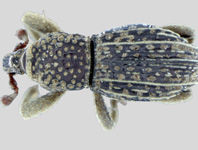Abstract
This paper reports a new weevil genus Devernodes gen. n. established for five new species from Southeast Asia: D. alkippe sp. n. (China: Mt. Emei), D. asteria sp. n. (Vietnam: Tam Dao), D. chthonia sp. n. (Vietnam: Tam Dao; the type species), D. drimo sp. n. (Malaysia: Pasoh Forest Reserve) and D. methone sp. n. (Malaysia: Tanah Rata). All Devernodes are wingless and inhabit the forest leaf litter. Adult Devernodes share a combination of two head characters unique among weevils in Asia: antenna with apparently unsegmented club and 6-segmented antennal funicle, as well as strong constriction separating the eye-bearing rostrum from the head capsule. To test monophyly and investigate phylogenetic relationships of Devernodes, Maximum Likelihood phylogenetic analysis was undertaken using parts of mitochondrial (COI) and nuclear ribosomal (28S) genes, as well as the nuclear internal transcribed spacer (ITS2) from 14 Devernodes and 55 outgroup Curculionidae specimens. Results strongly corroborated monophyly of Devernodes and did not suggest its realistic sister-group. The new genus is assigned to the molytine tribe Lymantini (not represented in the DNA analysis) based on two potential synapomorphies: head markedly constricted behind eyes and presence of undivided female hemisternites IX (= “merged coxite and stylus”). Thus interpreted, Devernodes is the twelfth nominal genus of Lymantini and the first record of the tribe outside of the Americas. All original data (localities, DNA sequences, specimen images) are available online in public datasets dx.doi.org/10.5883/DS-DEVERNO1 and dx.doi.org/10.5883/DS-DEVERNO2.
References
Alonso-Zarazaga, M.A. (2007) On terminology in Curculionoidea (Coleoptera). Boletín de la Sociedad entomólogica Aragonesa, 40, 210.
Alonso-Zarazaga, M.A. & Lyal, C.H.C. (1999) A World Catalogue of Families and Genera of Curculionoidea (Insecta Coleoptera) (excepting Scolytidae and Platypodidae). Entomopraxis, Barcelona, 315 pp.
Anderson, R.S. (2010) A taxonomic monograph of the Middle American leaf-litter inhabiting weevil genus Theognete Champion (Coleoptera: Curculionidae; Molytinae; Lymantini). Zootaxa, 2458, 1–127.
Anderson, R.S. (2016) A taxonomic revision of the genus Lymantes Schönherr, 1838 (Coleoptera: Curculionidae: Molytinae: Lymantini) in the United States of America. The Coleopterists Bulletin, 70, 111–124.
https://doi.org/10.1649/072.070.0115Anderson, R.S. & Marvaldi, A.E. (2014) 3.7.3 Dryophthorinae Schoenherr, 1825. In: Leschen, R.A.B. & Beutel, R.G. (Eds.), Handbook of Zoology, Arthropoda: Insecta: Coleoptera. Vol. 3. Morphology and Systematics (Phytophaga). Walter de Gruyter, Berlin, pp. 477–483.
de Pinna, M., Zuanon, J., Py-Daniel, L.R. & Petry, P. (2018) A new family of neotropical freshwater fishes from deep fossorial Amazonian habitat, with a reappraisal of morphological characiform phylogeny (Teleostei: Ostariophysi). Zoological Journal of the Linnean Society, 182, 76–106.
https://doi.org/10.1093/zoolinnean/zlx028Gillett, C.P.D.T., Crampton-Platt, A., Timmermans, M.J.T.N., Jordal, B.H., Emerson, B.C. & Vogler, A.P. (2014) Bulk de novo mitogenome assembly from pooled total DNA elucidates the phylogeny of weevils (Coleoptera: Curculionoidea). Molecular Biology and Evolution, 31, 2223–2237.
https://doi.org/10.1093/molbev/msu154Grebennikov, V.V. (2018a) Dryophthorinae weevils (Coleoptera: Curculionidae) of the forest floor in Southeast Asia: illustrated overview of nominal Stromboscerini genera. Zootaxa, 4418 (2), 121–135.
https://doi.org/10.11646/zootaxa.4418.2.2Grebennikov, V.V. (2018b) Dryophthorinae weevils (Coleoptera: Curculionidae) of the forest floor in Southeast Asia: three marker analysis reveals monophyly of Asian Stromboscerini and new identity of rediscovered Tasactes. European Journal of Entomology, 115, 437–444.
https://doi: 10.14411/eje.2018.044
Gunter, N.L., Oberprieler, R.G. & Cameron, S.L. (2016) Molecular phylogenetics of Australian weevils (Coleoptera: Curculionoidea): exploring relationships in a hyperdiverse lineage through comparison of independent analyses. Austral Entomology, 55, 217–233.
https://doi.org/10.1111/aen.12173Haran, J., Timmermans, M.J.T.N. & Vogler, A.P. (2013) Mitogenome sequences stabilize the phylogenetics of weevils (Curculionoidea) and establish the monophyly of larval ectophagy. Molecular Phylogenetics and Evolution, 67, 156–166.
https://doi.org/10.1016/j.ympev.2012.12.022Hebert, P.D.N., Cywinska, A., Ball, S.L. & deWaard, J.R. (2003) Biological identifications through DNA barcodes. Proceedings of the Royal Society B: Biological Sciences, 270, 313–321.
https://doi.org/10.1098/rspb.2002.2218Howden, A.T. (1992) Review of the New World eyeless weevils with uncinate tibiae (Coleoptera, Curculionidae: Molytinae, Cryptorhynchinae, Cossoninae). Memoirs of the Entomological Society of Canada, 162, 1–76.
https://doi.org/10.4039/entm124162fvLyal, C.H.C. (Ed.) (2010) Glossary of weevil characters. International weevil community website. Available from: http://weevil.info/glossary-weevil-characters (accessed 26 December 2017)
Lyal, C.H.C. (2014) 3.7.7 Molytinae Schoenherr, 1823. In: Leschen, R.A.B. & Beutel, R.G. (Eds.), Handbook of Zoology, Arthropoda: Insecta: Coleoptera. Vol. 3. Morphology and Systematics (Phytophaga). Walter de Gruyter, Berlin, pp. 529–570.
Maddison, D.R. (2013) The Tree of Life. Systematic Biology, 62, 179.
https://doi.org/10.1093/sysbio/sys057Marvaldi, A.E. & Lanteri, A.S. (2005) Key to higher taxa of South American weevils based on adult characters (Coleoptera, Curculionoidea). Revista Chilena de Historia Natural, 78, 65–87.
https://doi.org/10.4067/s0716-078x2005000100006Mortazavi, A., Hajiqanbar, H. & Lindquist, E.E. (2018) A new family of mites (Acari: Prostigmata: Raphignathina), highly specialized subelytral parasites of dytiscid water beetles (Coleoptera: Dytiscidae: Dytiscinae). Zoological Journal of the Linnean Society. [published online]
https://doi.org/10.1093/zoolinnean/zlx113Mugu, S., Pistone, D. & Jordal, B.H. (2018) New molecular markers resolve the phylogenetic position of the enigmatic wood-boring weevils Platypodinae (Coleoptera: Curculionidae). Arthropod Systematics and Phylogeny, 76, 45–58.
Oberprieler, R.G., Marvaldi, A.E. & Anderson, R.S. (2007) Weevils, weevils, weevils everywhere. Zootaxa, 1668, 491–520.
Ratnasingham, S. & Hebert, P.D.N. (2007) BOLD: the barcode of life data system. Molecular Ecology Notes, 7, 355–364.
https://doi.org/10.1111/j.1471-8286.2007.01678.xShin, S., Clarke, D., Lemmon, A.R., Lemmon, E.M., Aitken, A.L., Haddad, S., Farrell, B.D., Marvaldi, A.E., Oberprieler, R.G. & McKenna, D.D. (2018) Phylogenomic data yield new and robust insights into the phylogeny and evolution of weevils. Molecular Biology and Evolution, 35, 823–836.
https://doi.org/10.1093/molbev/msx324Zhou, Y.-L., Caterino, M.S., Ślipiński, A. & Cai, C.-Y. (2018) Cretohisteridae, a new beetle family from the Early Cretaceous of China, and its implications for the early evolution of the basal group of Histeroidea (Coleoptera). Systematic Entomology. [published online]
https://doi.org/10.1111/syen.12300

